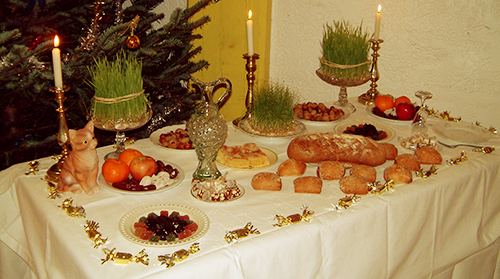
Lei Tretze Dessèrts is Occitan for the Thirteen Desserts (les treize desserts in French), the final course of le gros souper (the great supper), or le Réveillon, eaten after midnight mass on Christmas Eve.
The great supper is a highly symbolic affair: three white tablecloths are used to symbolise the Holy Trinity. Similarly, there are three lighted candles on the table, and three saucers of sprouted wheatgerm, which would have been planted on St Barbe’s day (December 4th). Tradition has it that if the wheatgerm has sprouted, the year ahead will be prosperous.
The meal consists of seven lean dishes (usually fish and/or vegetables), with which to remember the Seven Sorrows (or dolors) of Mary (the prophecy of Simeon, the flight into Egypt, the loss of the Child Jesus in the temple, the meeting of Jesus and Mary on the Way of the Cross, the Crucifixion, the taking down of the Body of Jesus from the Cross, and the burial of Jesus). This course is served with 13 bread rolls, which of course, represent Jesus and his 12 apostles.
Also representing Jesus and his followers is the final course, the Thirteen Desserts – the only part of the meal which is full of abundance. Consisting of pastries, sweets, fruit, and nuts, all 13 must be served at the same time, and every guest must partake of them. The desserts are left on until December 27th for other guests who may visit during Christmas.
Although the details vary from town to town, some things are consistent. The following is an example of les treize desserts:
Les Quatre Mendiants (the four beggars)
The four mendicant monastic orders are represented by dried fruit and nuts:
- Dominican (raisins)
- Augustine (walnuts or hazelnuts)
- Franciscan (dried figs)
- Carmelite (almonds)
Dates
These symbolise the land of Jesus’ birth, life, and death.
Dried plums
From Brignoles
Nougat
White for purity and goodness, and black for the forces of evil.
La Fougasse à l’huile d’olive / la pompe
A small, flat brioche made with olive oil, and flavored with orange flower water. It’s sometimes slashed to resemble an ear of wheat.
Les Calissons d’Aix
Similar to marzipan, these delicious leaf-shaped candies are usually made from a paste of ground almonds, and candied melon and orange, topped with a thin layer of frosting.
Les Biscotins
Also hailing from Aix-en-Provence, these butter cookies are delicately flavoured with orange flower water, or sometimes, marmalade.
Les Oreillettes
Thin, bumpy pastries, flavoured with citrus fruits.
Les casse-dents (the broken teeth)
Similar to biscotti, these hard almond cookies hail from Allauch, Marseilles.
Pain d’épices
This spiced bread is made with rye flour and honey, and flavored with anise, clove, nutmeg, and cinnamon.
Candied citron
The citron looks like a large, knobbly lemon with a very thick skin. This skin is chopped, cooked in sugar syrup, and then dusted with fine sugar.
Pâte de coings (quince cheese)
Not a cheese at all but a firm, sweet, deep red paste made from quinces, sugar, and vanilla.
Fresh fruit
No Thirteen Desserts would be complete without fresh fruit, and it’s not unusual to have a selection of apples, pears, oranges, melon, grapes, and tangerines.
What will be on your table this Christmas?
0



Leave a Reply